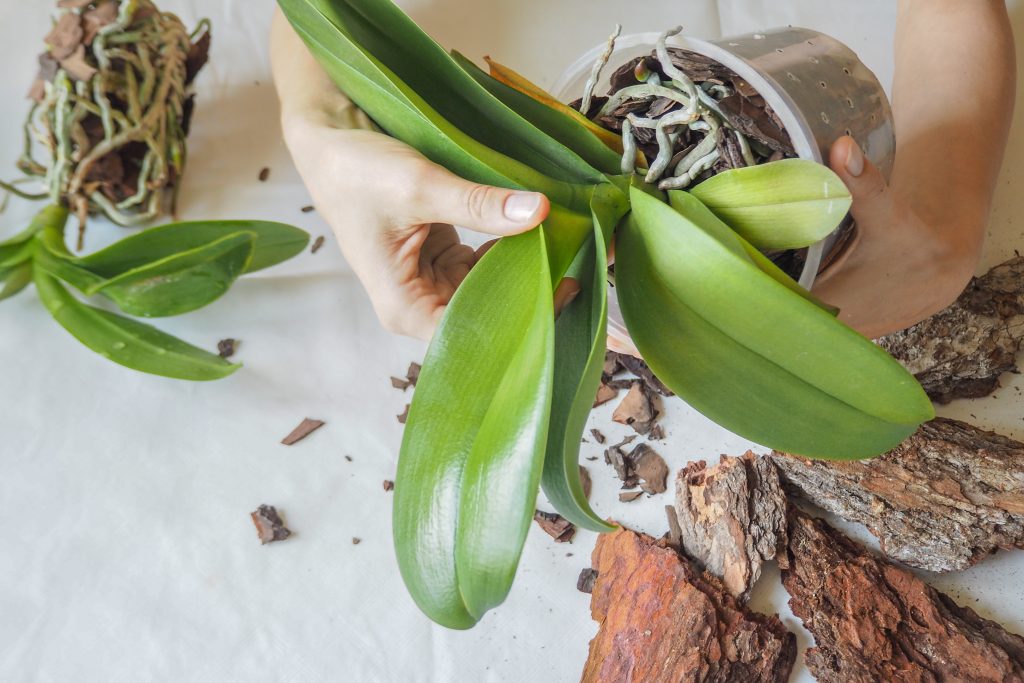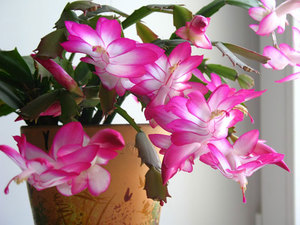 Alocasia is a tropical perennial crop with beautiful decorative leaves. If you purchased this flower, in order to avoid its death, you should study the rules for keeping at home.
Alocasia is a tropical perennial crop with beautiful decorative leaves. If you purchased this flower, in order to avoid its death, you should study the rules for keeping at home.
Please note that quality care implies creating a certain microclimate close to natural.
Content
Description of alocasia flower
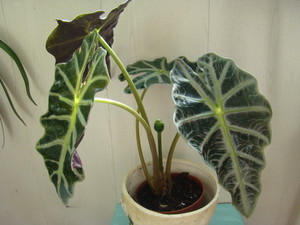 Alocasia, the photo of which is below, belongs to the aroid family. This species grows in Southeast Asia. Malaysia and the Philippines are considered its homeland. The total number of plants reaches 70 species.
Alocasia, the photo of which is below, belongs to the aroid family. This species grows in Southeast Asia. Malaysia and the Philippines are considered its homeland. The total number of plants reaches 70 species.
Some species have similar characteristics. This is a plant with enough large evergreen leaves leathery structure with veins and heart-shaped. The leaves themselves are also interesting in that they have so-called water estuaries or tubules.
When the plant is in humid conditions, water droplets can appear on these tubules, which helps to use the plant as a "weather predictor". The total size of the culture can reach 40 cm and grow up to two meters in height. Plant flowering outside natural conditions is a rather rare occurrence.
When kept at home, all breeding methods are impossible for alocasia, and there are quite a lot of them in wild growth (vegetative, root, seed).
Flowering usually occurs in plants aged 5-7 years. The culture fades very quickly, and it is quite difficult to achieve flowering, as already mentioned, at home.
Therefore, one of the most important aspects of home care is ensuring optimal conditions for the full cycle of all processes.
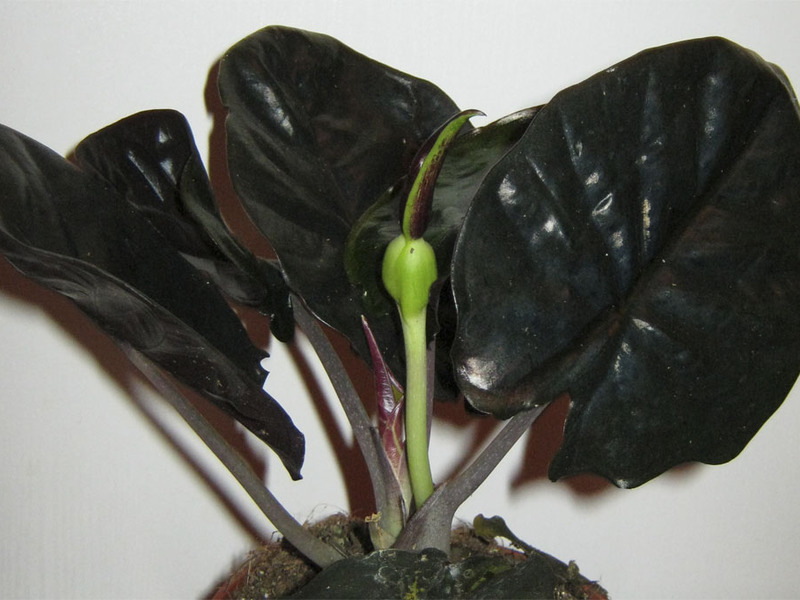
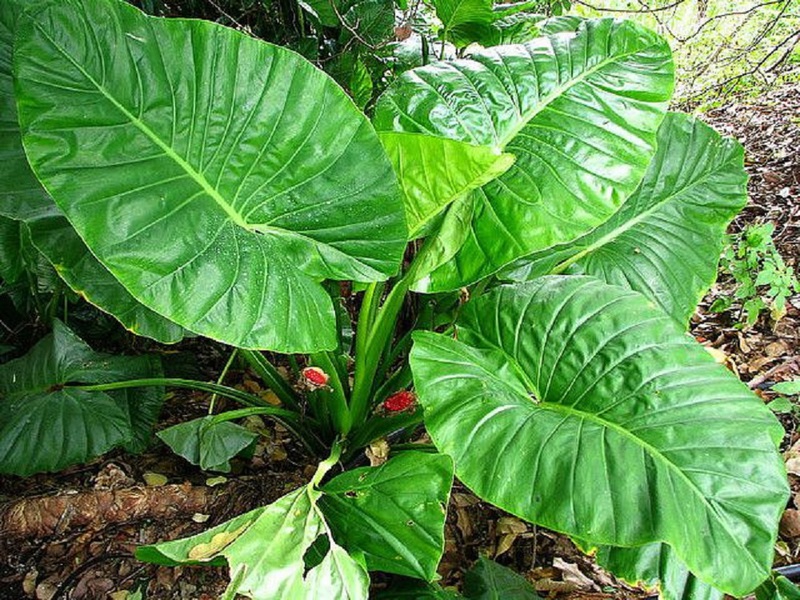
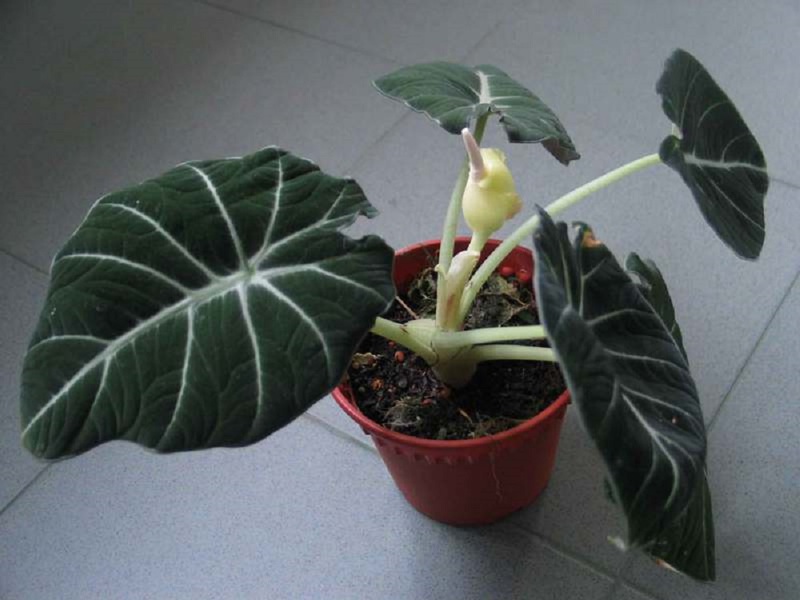
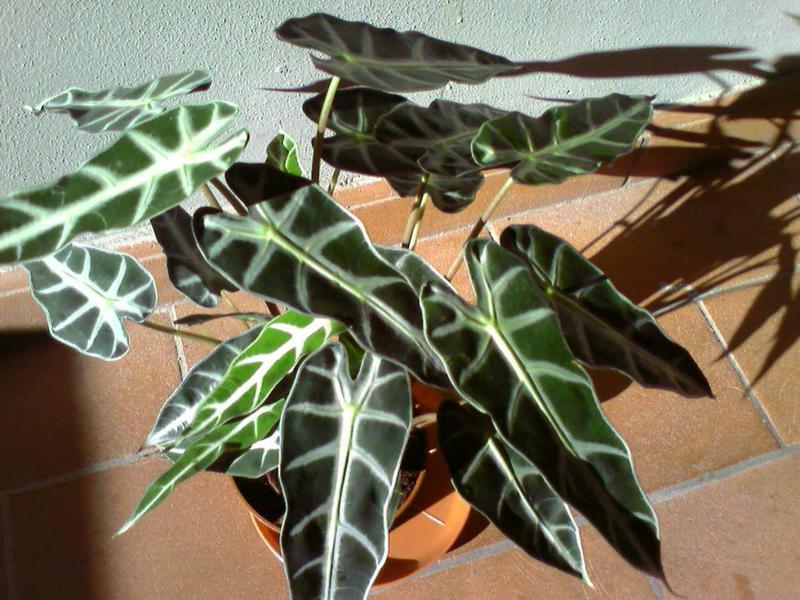
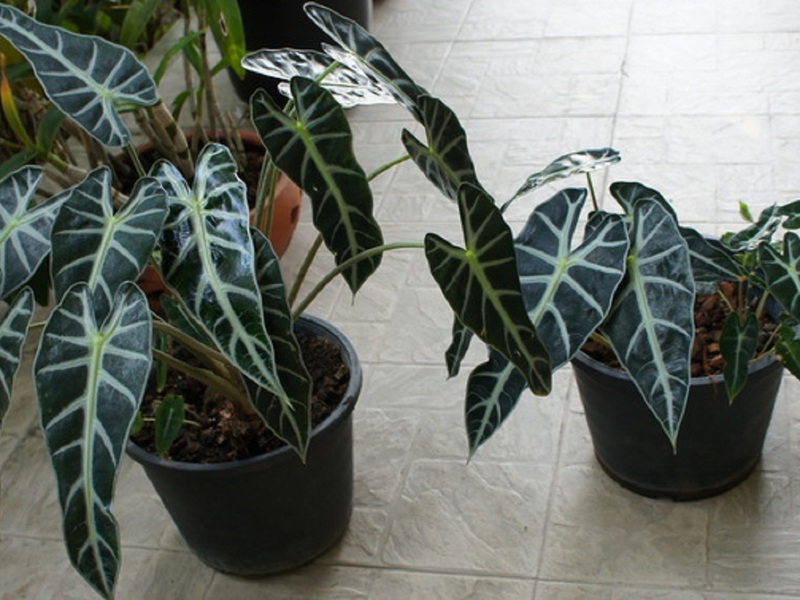
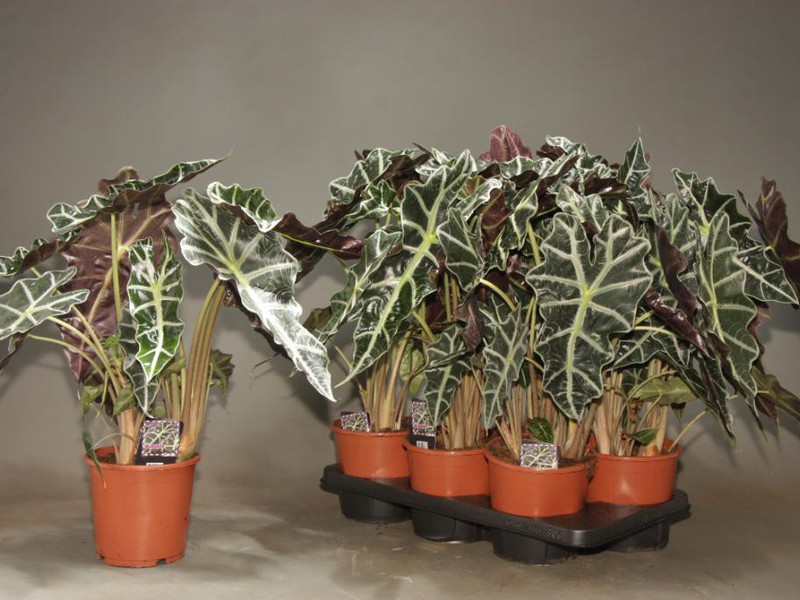
Alocasia blooms only in an adult plant. Flowers are small and fragrant, collected in an inflorescence-ear of white-pink color, fully or partially covered with a cover sheet.
The bedspread at the flower is painted in whitish-greenish, pink-white colors. Pollination forms fruit-berries with seeds inside. Alocasia flowers have the following varieties:
- Copper red alocasia — one of the most unsafe for home keeping, plants. Although it differs in pronounced decorative properties, it itself is quite poisonous.
- Large-leaved alocasia is one of the largest plants of its kind. The plant itself can reach two meters in height, and the leaf size exceeds 80 cm.
- Alokazia Black Velvet (Black Velvet) - the most "often blooming" of all representatives of these plants. Has fairly squat overall proportions. The leaves reach a size of 35 cm and have an elongated end. The main stems reach a length of 10 cm.
- Alokazia Amazonian - belongs to the most common among flower growers and lovers of this plant, since it is more interesting in decorative terms. She has rather large leaves, reaching a length of 60 cm.
- Alocasia Sandera - has a similar appearance to the Amazonian alocasia, but the shape of the leaves has the most elongated outlines. The length reaches about 40 cm. In home conditions, flowering does not occur.
- Alocasia Polly - is a hybrid type of alocasia Sander. It adapts very well to home living conditions, and also has high decorative properties, for which it can rightfully be called the favorite of flower growers.
Having considered the main types and features of this plant, it is worth moving on to the most important topic of our article - this is caring for alocasia in home breeding conditions.
Optimal living conditions and care
 Correct and optimal care for this plant should be considered the possibility of its reproduction without depleting the plant itself during its flowering period, as well as achieving this very flowering.
Correct and optimal care for this plant should be considered the possibility of its reproduction without depleting the plant itself during its flowering period, as well as achieving this very flowering.
Many experienced florists can tell how much the content is not easy and care for alocasia. Since she is prone to frequent illnesses and does not always have such an attractive appearance as we would like.
But, if you approach the issue of caring for a plant with all care and attention, then it will certainly answer you with a healthy appearance and beautiful flowers.
In the care of alocasia, a number of certain rules should be observed:
- This plant is very sensitive to water stagnation both in the soil and in the leaves. Usually, excess moisture is manifested in leaf rot and the appearance of various spots on them. Therefore, in a pot with a plant, an expanded clay layer with a thickness of about 1−2 cm must be present.
- Along with this, alocasia is a rather big lover of humidified air. To moisten the leaves, you can use a spray bottle or wipe the leaves, making sure that moisture does not accumulate in the veins.
- Drafts and cold indoor air also negatively affect the condition of alocasia. The optimum temperature for alocasia is about 22 degrees.
- Regular watering of the soil is required.
- The plant is sufficiently light-loving, however, direct sunlight should not be allowed to fall on the plant. In winter, fluorescent lamps or phytolamps can be used as lighting.
Soil and fertilizer
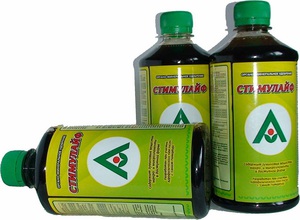 The soil for the plant is best used specially designed, selected for the aroid family. If this is not possible, then it is quite possible to prepare the necessary soil yourself.
The soil for the plant is best used specially designed, selected for the aroid family. If this is not possible, then it is quite possible to prepare the necessary soil yourself.
To do this, mix in equal parts: bark, vermiculite, river sand. Don't forget the drainage layer! It is important. Top dressing of the soil is best done once every two weeks by any mineral or organic fertilizer.
No fertilization is required in winter. A flower transplant should be carried out as needed.
Usually, the transplant is done in the spring, as a rule, this is March. Transplanting may well be replaced by "reloading" (while preserving the common earthy lump) of the flower into a more spacious container.
Reproduction of alocasia at home
Formation of fruits, in a home environment, almost never occurs. One of the best breeding methods is division of plant tubers... Reproduction of alocasia can occur in several ways:
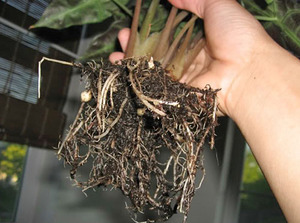 one of these is propagation by seeds, however, not all species of this plant tend to bloom under domestic conditions;
one of these is propagation by seeds, however, not all species of this plant tend to bloom under domestic conditions;- the most common for home cultivation of this flower is also reproduction by dividing the bush;
- there is also a type of propagation by the cuttings of the plant;
- another breeding method is with the help of daughter tubers.
Since in conditions remote from natural, alocasia practically does not produce seeds or seeds are not full-fledged carriers of all the properties of the main plant.
But if you have ready-made alocasia seeds, then you should immediately plant them. Usually they are buried into the ground to a depth of about 1–2 cm. The total period of seed germination can take about three weeks.
Propagation by cuttings... This method is most suitable for plants with green leaves. The cutting part of the plant is cut at an acute angle and processed in a root growth stimulator solution. Subsequently, the cut part is either placed directly into the ground, or left in water until the roots appear.
Tuber propagation possible only on condition that the plant produced similar tubers. They are carefully cut and placed in water or moist moss. Indoors, it is necessary to create conditions of increased moisture content for optimal growth of the root system of tubers.
It should be mentioned that alocasia is sufficient poisonous culture, therefore, during transplanting and caring for it, it is best to use hand protection (gloves), and also thoroughly rinse them with soapy water after contact with leaves.
If this flower is present in your home, it is very important to ensure that it is not accessible to small children and pets. But, one way or another, alocasia is a very common pet for many gardeners and home plant lovers.
Therefore, it is worth paying enough attention to her care and then alocasia will bring joy to your eyes, cheer up with an unusual appearance, and decorate the interior.
Possible difficulties and advice from experienced florists
 Slow plant growth - lack of nitrogen in the soil. It is necessary to feed alocasia with a urea solution.
Slow plant growth - lack of nitrogen in the soil. It is necessary to feed alocasia with a urea solution.- Withering leaves of alocasia - overdrying or waterlogging of an earthen coma. The irrigation method should be changed. Another reason may be that the substrate is too heavy. It is necessary to replace the substrate with a more suitable one.
- The leaves lose color or turn pale - lack of light. Adjust the illumination. If the plant is in shade for a long time, then it is necessary to accustom it to more lighting gradually. Backlighting is desirable in winter.
- Dry brown tips of the leaves - too dry indoor air or lack of watering. Plant spraying and moisture control is necessary. Dark spots appeared on the leaves - hypothermia or drafts.
- Small and expressionless leaves - lack of light. The tips of the leaves turn yellow when irrigated with hard or chlorinated water, when there is a lack of nutrients in the soil or an excess of nitrogen.
